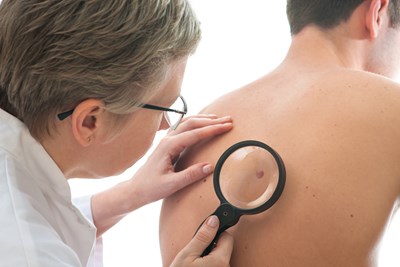What is Skin Cancer?
Skin cancer is the most common form of cancer in the United States. 75% of all diagnosed cancers are types of skin cancer. It is also one of the few types of cancer that affects similar subsets of the population regardless of age, gender, or race.
Skin cancer forms when abnormal cells develop and multiply in the layers of the skin. This development is caused by mutations of DNA within the individual cells of the skin. Mutations are the result of many factors including radiation and toxic chemicals. Skin cancer has very high survival rates if diagnosed early; however, this type of cancer is of major concern due to the rising number of people affected. Skin cancer is one the easiest forms of cancer to be diagnosed because it can be visually seen and caught in early stages. Signs of skin cancer often appear first on the head, neck, or back, though they can also develop on any other part of the body.
There are three different types of skin cancer: basal-cell carcinoma, squamous-cell carcinoma, and perhaps the most widely-known type, melanoma. The first two types are, by far, the most common forms of skin cancer. These two forms, while serious, do not typically spread. The third form, melanoma, is infamous because of its tendency to spread cancer throughout other areas of the body.
What Causes Skin Cancer?
Excessive exposure to the sun is the most common cause of skin cancer. The ultraviolet sun rays alter the genetic material in skin cells. This causes mutations which lead to cancerous cells. Ultraviolet light can also come from tanning booths, sunlamps, and x-rays. The basal cell and squamous cell carcinoma types of cancer have been positively linked to chronic sun or UV exposure. It has been found that one blistering sunburn during childhood nearly doubles a person's risk of skin cancer later in life. Other factors leading to skin cancer include tobacco use as well as environmental factors such as chronic exposure to x-rays or certain chemicals including arsenic and petroleum products.
What Are the Symptoms of Skin Cancer?
Each type of skin cancer has its own signs and symptoms. Basal-cell skin cancer is the most common form skin cancer. This type of cancer accounts for three out of four diagnoses. It often looks like sores, or red patchy growths that often bleed. Squamous-cell carcinoma is a more aggressive than basal-cell and typically affects deeper levels of the skin. This type often resembles scaly or crusty wart-like growths. Melanoma is the most dangerous form of skin cancer. Though it is a rarer form, it causes the majority of skin cancer related deaths. Melanoma often resembles irregularly formed moles with variations in color. Inform your doctor if you notice any of these symptoms or any wounds in the skin that have not healed after a prolonged amount of time. Not all skin changes indicate cancer, but an examination by a doctor and a testing of the affected area can determine for certain.
Skin cancer also seems to have a genetic link. A family history of skin cancer increases the risks of developing a positive diagnosis. Fair skinned people are most at risk because they are born with the least amount of melanin in their skin, though this does not mean that naturally dark-skinned individuals are not at risk for skin cancer. Squamous-cell carcinoma is the most common form of skin cancer for African-Americans. Melanin is the skins natural protection against the sun and ultraviolet rays. Geographic location is also a factor in the risk of skin cancer. Places that get more sunshine per day put people at higher risk. Examples include Arizona, Hawaii, and places nearest the equator. Lifestyle may also play a role. People who work or spend a great deal of time outdoors are more susceptible to skin cancer. Individuals with lowered immune systems also have greater risks of developing skin cancers.
How Can You Prevent from Skin Cancer?
Limiting exposure to sunlight is the surest way to lower your risk of skin cancer. If limiting exposure is not a viable option, take measures to protect yourself. Avoid the sun during its peak hours. This is between 10 am and 2 pm. Wear protective clothing such as pants, long-sleeve shirts, sunglasses, and a wide-brimmed hat. Apply and use sunscreen liberally. A broad-spectrum or full-spectrum sunscreen will offer full protection. This type of sunscreen will protect from both types of ultraviolet light. UVA rays prematurely age skin and cause wrinkles. UVB are the type of rays that cause sunburn.
How is skin cancer treated?
Treatment depends upon the size, depth, and location of the cancer. Treatments include freezing the affected area with very cold liquid nitrogen. More invasive methods include excisional surgery or Mohs surgery in which the cancerous cells are removed in layers until on the healthy skin cells remain. These types of surgeries are localized and limited only to the affected areas. For more invasive cancers, traditional cancer treats of chemotherapy or radiation may be used. These treatments are typically used to halt the spread of cancer when it has moved beyond the skin.



